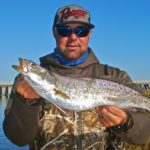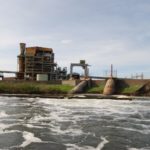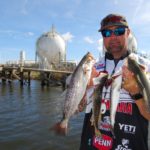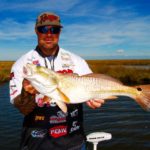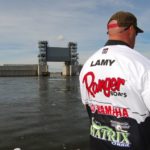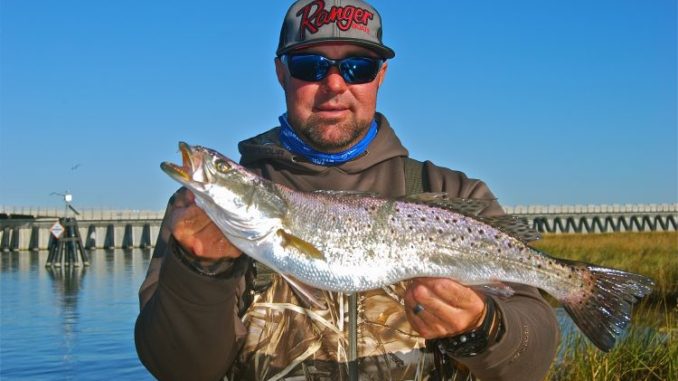
For the first time in a generation, anglers won’t be able to bank on the Hot Water Canal to catch specks and reds near Chalmette. But that doesn’t mean you should stay home. Here’s one guide’s tips for targeting the area this winter.
For Chalmette-area wintertime anglers, the Hot Water Canal was about as close as you could get to a sure thing.
Warm, toasty water from Entergy’s Michoud generating facility discharged into a nondescript, otherwise unremarkable canal adjacent to the Intracoastal Waterway near the Green Bridge.
It might not have looked like much, but local anglers knew just how special it really was: No matter what the actual water temperature in other parts of the marsh, you could bank on the area near the mouth of the Hot Water Canal being at least 8 to 10 degrees warmer.
And warm water meant hot fishing — even during the coldest days of winter.
“When we hit February and it was freezing outside — and most people would not dare even set foot on a boat — we knew that we could go to the Hot Water Canal because the water temperature there was going to be warmer,” said Capt. Bubby Lamy of In & Out Charters in Slidell. “Fish were attracted for the warmth, and bait went there for the same reason.
“And the fish that were there could be much more active because they were warmer.”
Beneath the steaming water, you could almost picture speckled trout and redfish stacked up and patiently waiting in line for a day at the spa, complete with stone massages, hot tubs, mud treatments, bait hors d’oeuvres and miniature hot towels.
But alas, all good things must come to an end, and the spa is officially closed this winter.
Entergy recently completed a $30 million project to upgrade its power transmission system into New Orleans from its Ninemile facility in Westwego, and the aging Michoud plant will be shuttered.
And just like that, the hot water that had poured into the now-famous canal since the 1960s is gone — leaving local anglers pondering for the first time in a generation what winter fishing will be like without it.
Lamy admitted things will be different in the coming months, but he was quick to point out that hotspots in the area — including The Wall, the Guillotine Lock, Boh Brothers, the rocks along the Mississippi River Gulf Outlet and the Michoud slip — stand on their own merit, even without the benefit of hot water.
“Water temperature isn’t the only reason that’s a good area to fish,” he said. “Another reason is there’s lots of deep water, and those fish are able to go deep when it’s really cold, then come up to the shallower stuff when the sun rises and the water warms up.
“In that area, it’s almost the exact same fishing each place you go: You have rocks, deep water, moving water and ledges. You just have to find the pattern that’s working on your particular day.”
No matter where he’s fishing in the area, Lamy is a big believer in a ⅜-ounce jighead to get your lure down — unless he’s targeting redfish or bass in the nearby Bayou Bienvenue marsh.
“As soon as I pull in there, I’m changing to a 1/4-ounce,” he said. “I won’t throw a ⅜ there because it’s so shallow that it will go straight to the bottom.
“Before you even click your bail to keep it swimming, it’s already sunk in the mud before the fish can even see it.”
Plastics-wise, his favorite artificial lures in the winter for the Chalmette area are lemonhead, pink champagne and ultraviolet from Matrix Shad. If he’s fishing under a popping cork, he goes with Matrix’s shrimp creole on a ⅛-ounce jighead, and if he’s heading to the marsh, he favors purple haze.
Depending on his exact location, he gauges the trout bite starting at about 18 feet deep, noting trout head for the depths to find warmer water when the mercury drops.
“Speckled trout are not typically going to go past 30 feet, so 18 feet is a good place to start,” Lamy said. “You can be in 18 feet and cast out to 26 and let it hit the ridge, and then come up to see where they are.
“Or, you can cast it shallow and let it drop off. Eighteen feet is a good baseline to locate where they are holding.”
Without the benefit of hot water pouring into the Hot Water Canal this year, Lamy shared his Top 5 spots in the area where he plans on targeting specks and reds this winter.
1. Boh Brothers Construction Yard
On the Intracoastal Waterway on the other side of the green bridge from the Hot Water Canal lies Boh Brothers’ Almonaster Operations Center, a spot where rocks, ledges and a sandy beach all come into play for more fish.
“There’s a sandy bottom on the south side that’s pretty shallow — 4 to 6 feet,” Lamy said. “To find them at 18 feet, you’re going to feel like you’re almost in the middle of the canal, and they can be there. Wherever you find them, they’re going to be there for a little while.
“We very seldom sit in that area: We’re on a constant drift. I don’t think I’ve ever dropped the anchor there.”
There’s also a big flat coming from the rocks with a steep ledge that falls off into the deeper water, he said.
“You can get on that ledge and bounce plastics up or down, depending on how those fish are sitting,” Lamy said. “You won’t know until you try it, but once you figure it out you can fish that whole stretch doing the same thing.”
2. The Michoud Slip
Located just east of the Hot Water Canal, the Michoud slip is another spot where you can fish deep — or target fish along the rocks.
“In the back there’s a big pond that’s 25 feet deep, so the fish can huddle up in that deep water (and) then spread out to the rocks bordering the pond,” Lamy said. “And the slip runs north and south, so if the wind is coming out of the east or west, it’s going to be calm.”
3. The MRGO
In the MRGO, Lamy targets the rocks from the Chalmette Wall to the Violet locks because of the warmth they provide as the sun rises.
“I mostly fish the rock side, but that’s not to say the other side isn’t good,” Lamy said. “The 18- to 22-foot mark when it’s super cold is a good range to use.
“Keep fan-casting until you get bites. You just have to find them.”
And, especially in the winter, Lamy said it’s important to vary your presentation — and speed.
“I really jig it hard at first to see what happens,” he said. “But they might be looking for it a different way. So don’t be afraid to let it sit or barely move it.
“If you’re not catching, change up your presentation some — especially if you were catching on a color then all of a sudden you’re not.”
But remember that colder water temps mean more lethargic fish.
“You want to slow your presentation down anyway because they’re a little slower,” Lamy said. “You don’t want to move it so fast that you’re pulling it past their face. They’re trying to eat as much as they can and use the least amount of energy possible.”
4. The Guillotine Lock
This lock in the Chalmette Wall is a hotspot because of the water — and bait — that constantly move through the area.
“Those fish are able to sit out in front of it on a falling tide, and bait gets washed through there. Bait is coming to them,” he said. “There’s no work; the only energy they need to exert is sitting in the current.”
If the tide is falling, Lamy recommended positioning yourself on the east side of The Wall. If it’s rising, move to the west side.
Water depths there range in the mid-20s, he said.
“It’s a choke point moving through there,” Lamy explained. “And on the front and back side of The Wall, that’s all deep water. You have some spots where they have holes where it will drop from 18 to 24 feet all along there.”
5. The Bayou Bienvenue marsh
Situated between the MRGO and the Intracoastal, the Bayou Bienvenue marsh is a great spot to head if you want to sight-cast for reds or target green trout.
“I’m looking for ripples, nervous water and tails,” Lamy said. “Blind-cast pockets close to the shoreline up against the grass. That’s where those fish are swimming and traveling, so you really want to be near the grass.”
So even though the old reliable Hot Water Canal won’t be in play this winter, Lamy suspects the fishing around Chalmette will still be solid — even if anglers have to work a tad harder than they have in the past.
“Only time will tell on how much of an impact this will really have,” Lamy said. “Those times when it gets really cold, like January and February, will test this whole scenario.
“Once we see what happens then, we’ll really be able to tell how the Hot Water Canal closing will affect the fishing.”
Capt. Bubbly Lamy with In & Out Charters can be contacted at 504-982-6850 or via the Web at www.inandoutcharters.com.
